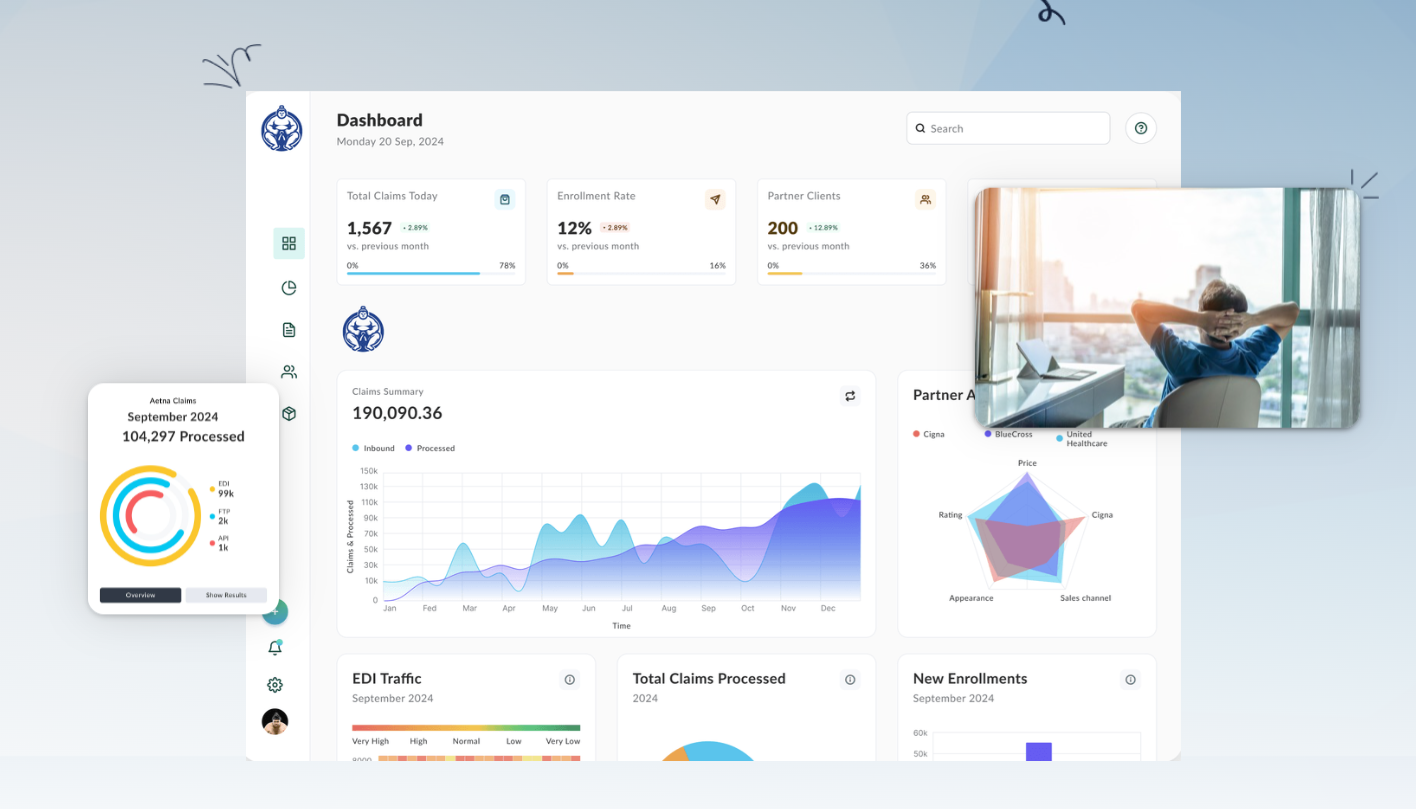Understanding EDI Transaction Sets: A Practical Guide for Healthcare Insurance Operations


EDI (Electronic Data Interchange) transaction sets are the connective tissue of the healthcare insurance ecosystem. For payers, providers, and partners, they’re the means by which enrollment, eligibility, claims, and countless business relationships are seamlessly managed—if implemented and handled correctly. But for many healthcare insurance organizations, truly understanding and wrangling the many transaction sets (834s, 837s, 277s, and more) can feel overwhelming. At EDI Sumo, we live and breathe this complexity every day and want to share a practical, insider’s perspective on what these transaction sets are, why they matter, and how a smarter operational approach unleashes their true value.
Demystifying EDI Transaction Sets in Healthcare Insurance
At their core, EDI transaction sets are standardized electronic documents that govern how data is exchanged between organizations. Each set is identified by a unique number and layout, carrying a specific business purpose. In healthcare insurance, this might mean enrolling a new member, submitting a claim, or reporting the status of a transaction.
Why Transaction Set Standardization Matters
- Interoperability: Standardization means two organizations—even with different internal systems—can reliably exchange information.
- Compliance: Formats like EDI 834 or 837 are mandated by HIPAA and other industry requirements.
- Efficiency: Automation only works when the data structures are predictable, repeatable, and validated.
- Auditability: The right format supports audit trails and quality checks, vital for both regulatory and business objectives.
The Most Common Healthcare Insurance EDI Transaction Sets
For anyone working in a payer organization, there are several EDI transaction sets you’ll encounter daily. Here’s a hands-on look:
- EDI 834 – Benefit Enrollment and Maintenance: Used for sending member enrollment information from employers or agencies to insurance providers. Critical for onboarding, updating, or terminating member coverage.
- EDI 837 – Healthcare Claim: Governs medical, dental, or vision claims submissions from providers to payers. Ensures claims are processed accurately and quickly.
- EDI 277 – Claim Status Notification: Lets payers report the status of a claim back to providers. Reduces support backlog and confusion about claim outcomes.
- EDI 999 – Acknowledgment: Provides confirmation that a sent transaction (such as an 837 or 834) was received and understood at a structural level.
- EDI 270/271 – Eligibility Inquiry and Response: Enables providers to check patient eligibility and receive real-time answers before services are rendered.

Practical Challenges Behind the Scenes
From the outside, EDI sets look fairly straightforward—the documentation is public, the standards are well defined, and everyone “should” be following the same rules. The complexity, however, explodes in real-world operations:
- Diversity of Formats: Not every partner sends EDI. You’ll deal with Excel, CSVs, XML, and even positional text files. Each must be mapped, validated, and standardized before integration.
- Custom Business Rules: Payers, states, and agencies frequently add custom fields or validation needs on top of the standard. Miss one, and your process grinds to a halt.
- Data Quality: Incomplete, inconsistent, or erroneous submissions are rampant. Without tight automation and exception handling, manual cleanup is relentless.
- System Integration: Where does the data go? Claims administration, CRM, data warehouses, regulatory reporting… all must be connected and kept in sync.
- Audit and Compliance Pressure: HIPAA and internal audits demand traceability—from the moment a file is received until it loads into the core system.
Enhancing Operations With Smart EDI Management
We’ve seen how legacy manual processes or “bare minimum” EDI toolkits put unnecessary strain on payer IT and business teams. Instead, modernizing EDI operations opens up immense opportunities for efficiency, accuracy, and transparency. Here’s where a comprehensive approach makes all the difference:
1. Automated Ingestion & Normalization
- Accept all file formats—from EDI and XML to Excel or positional text—without reengineering your core systems.
- Standardize and translate the data automatically to minimize human intervention and downstream errors.
2. Real-Time Monitoring and Error Management
- Proactive dashboards to track inbound, outbound, and in-motion files. No more “black holes” for where a submission is stuck.
- Error detection, instant notifications, and drill-down for rapid issue resolution—before SLA deadlines are missed.
3. Compliance and Audit Readiness
- Automatic generation of audit trails—what was received, changed, moved, and loaded, and by whom, at every step.
- Simplified reporting structures built for internal QA, HIPAA, and external partner audits.
4. Empowering Business and Support Teams
- Controlled, user-friendly access to eligibility or claim data—removing reliance on IT for every support query or file re-processing need.
- Instant historical lookups and discrepancy investigation—support agents are no longer left waiting or unsure.
Where Do Most Teams Go Wrong?
Despite the clear benefits of efficient EDI management, we often see payer organizations struggle with a few core missteps:
- Underestimating Upstream Data Problems: The data itself is often far messier than most project timelines or budgets allow for. Decoding the variety of formats is a project in itself.
- Short-Term Point Solutions: Buying a converter for just the 834 or outsourcing only claims handling leaves you with siloed, brittle systems that break down when the business grows or partners shift.
- Lack of Visibility: Manual tracking or outdated EDI modules lead to a constant state of “guessing” about where files are, if/when errors will be caught, and how compliance is holding up.
EDI Sumo’s Approach—Practical, Modular, and Payer-Focused
We designed EDI Sumo from the ground up for the true operational realities of healthcare payers. Our platform handles:
- Payroll, broker, agency, and direct group enrollments (834, CSV, Excel, XML, any custom file type)
- Automated, real-time monitoring of claim submissions (837s) with support for WEDI/SNIP Levels 1-7
- Role-based dashboards for customer service, eligibility/claims pros, and IT teams
- Modern audit and compliance workflows to stay regulations-ready at all times
- Deep integrations with claims, eligibility systems, leading payer platforms, and trading partners—making sure your entire workflow stays joined up
- End-to-end encryption and enterprise-grade controls to protect sensitive member, clinical, and financial data
Integrations That Work With Your Reality
No two healthcare organizations have the same technical setup, nor should they be forced into cookie-cutter solutions. EDI Sumo’s modular architecture means we plug right into your systems—whether that’s claims management, EDI translators, or direct SFTP. Our extensive integration options for major payers like Blue Cross Blue Shield, Aetna, Cigna, UnitedHealthcare, and enterprise B2B tools like IBM Sterling are designed to work with your current and future partners.
Security and Compliance—Always On
With HIPAA and GDPR fines on the line, and data breaches never far from the headlines, robust security is non-negotiable. EDI Sumo provides enterprise-grade encryption for all data in transit and at rest, strict access controls (role-based, OAuth2/MFA), and compliance monitoring so your team and your board stay confident—even as partners, formats, or regulations change.
Action Steps: Making EDI Transaction Sets Work for You
- Catalog Your Data Flows: List all inbound/outbound transaction sets, sources, and formats. Don’t forget those "non-EDI" files in the mix.
- Map Integration Points: Where does data need to go? Which teams or departments require access—and what is the ideal workflow?
- Evaluate for Automation: Where are you still relying on manual imports, reviews, or email chains? Prioritize quick wins with automation.
- Implement Real-Time Monitoring: Invest in dashboards and alerting so errors or delays are surfaced proactively—not after SLA penalties hit.
- Harden Audit Trails and Security: Ensure every transaction is traceable, all access is accounted for, and sensitive data stays encrypted end-to-end.
The Value of Getting EDI Transaction Sets Right
For payers, the stakes have never been higher. Member experience, operational efficiency, and compliance risk are all directly tied to how well you handle EDI transaction sets—from classic 834s and 837s to your inevitable spreadsheet import. With the right strategy and tools, wrangling this complexity doesn’t just protect your organization—it lets you innovate, scale, and serve your customers more effectively than ever before.
Ready to make sense of your EDI landscape, streamline operations, and empower your business teams? Let's connect with EDI Sumo to explore how practical, purpose-built EDI management can give you the visibility, compliance, and efficiency your organization deserves.


.png)





.png)

.png)


.png)
